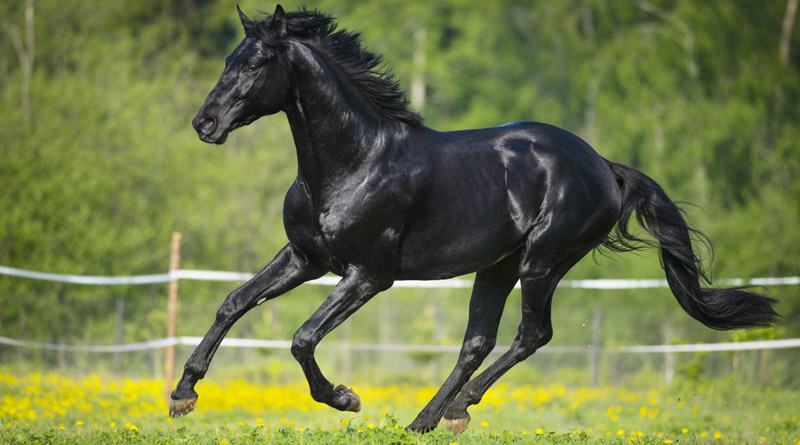horses
horse ages
Have you ever wondered how old you are in horse years? Or, have you wondered how old your horse is in human years? There are no hard and fast equivalents. Horses and humans age and mature at different rates. So all comparisons are only estimates and shouldn't be taken too seriously. Research completed in 2003 by equine veterinarians has compared the stages of human ages to horse ages. The chart below is based on that research as published by Equine Resources International. It's important to remember that many things affect aging like basic care, size, genetics, and overall health, just as in humans. Factors That Affect Equine Aging For example, ponies mature faster but live longer than larger horses. Some age record breakers have been ponies. Poor health will shorten a horse's life and may delay or damage its physical development. Nutrition and workload play a huge role in equine aging. This makes it very difficult to make an accurate match between horse and human age. This is only one of the several charts that try to map out horse-to-human age comparisons. Horses mature much faster than humans do. Horses may be more likely to die from a disease or colic than of old age. On the chart you see here, under the age of one year old, there is no comparison. A human infant may take over a year to learn to walk, but a horse will walk within an hour after birth. Human infants may start eating solid food at about six months, but foals will start imitating their mothers and nibble on grass within weeks or even days after birth. Overall, all aspects of growth are much faster for a horse than a human. And although the chart suggests that a yearling horse is equivalent to a six-year-old child, that is only very approximate as a six-year-old child won't be able to feed itself or otherwise interact socially and look after itself like a yearling horse. Horse are independent as soon as they are weaned from their mother's milk. Not so with humans who need several years of nurturing before they are truly adults able to live on their own. It will be a long time before a child can provide itself with all the nutrition it needs, especially if you consider that human food must be hunted, gathered or grown.& nbsp;
riding

Look at the horse’s expression to understand them. If the ear is back, it means that they are not comfortable or afraid. If the ears are upfront, it means that they are interested.When getting on the horse, get on and sit gently to prevent back pain for the horse. Do not rush! Be gentle and patient while learning. It takes more than 10 years to become advanced.Never stop taking lessons even if you are advanced. There is always place for improvement.
equipment
If you’ve decided you want to ride a horse, you’re going to need to purchase all of the necessary tack and gear. Some people use these words interchangeably, but they aren’t actually the same thing. Tack applies more to items you need to actually ride, including a saddle, bridle, bit, stirrups, reins, cinch, blanket/saddle pad, spurs, etc. Gear, on the other hand, usually refers to the items you need to keep your horse comfortable and groomed, such as brushes, feed buckets, etc. Basically, if it’s used in riding, it’s tack, while if it’s used in the stables, it’s gear. For beginners, there is a learning curve involved in figuring out how all of your tack goes onto your horse and what exactly it does. Every new rider has to learn this, and there’s no harm asking for help. Here’s a look at how what some of these common tack items are used for. Saddle: This one is pretty obvious. The saddle helps you remain balanced on the horse, plus it gives you something to hold on to. There are different types of saddles for dressage, jumping, trail riding, etc. Saddle Rack: A stand to keep your gear off the ground, keep it safe and make it easily accessible. Halter: This is the leather harness that goes around your horse’s head. You use it along with a lead rope to lead the horse around. Bridle: The bridle is also around the horse’s head, and it looks similar to a halter. It includes both the bit and the reins, and it’s used to guide the horse in different directions.. Bridles that use a noseband but not a bit are called hackamores. Reins: A part of the bridle, the reins are the long leather straps that the rider holds. They are connected to the outer sides of the bit. Bit: The bit is a small metal piece that goes in the horse’s mouth. It sits on the gums, not the teeth, and is held in place by the bridle. It’s connected to the reins and helps transmit the rider’s commands to the horse. Used correctly, bits do not hurt the horse in any way. Breastcollar: Sometimes called the breastplate or breast girth, these straps connect from the saddle down across the horse’s chest and around its front legs. They are normally used at events that require the horse to jump. Girth: The girth, also referred to as the cinch, is the leather strap that holds the saddle in place. Blanket/Saddle Pad: A saddle pad or a blanket is put down before adding the saddle to help keep the saddle from rubbing on the horse and causing irritation. Stirrups: The stirrups are loops of leather that hand down on either side of the saddle. Rider place one foot in a stirrup, grab hold of the saddle, and pull themselves up onto the horse. They also place their feet in the stirrups while riding.